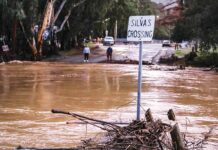Water district holds the line on South County ag water rates
Gilroy – County farmers faced with rising fuel costs and a labor pinch are getting a break from the Santa Clara Valley Water District, which decided last week to slash water rates for North County farmers and hold the line on rates for hundreds of their South County peers.
Farmers who participate in water quality programs can reduce rates even further under a partnership-in-the-making between the water district and the Santa Clara County Farm Bureau, an agency with close ties to many of the county’s roughly 500 farms.
In the fiscal year starting next month, farmers tilling soil north of Metcalf Road will only have to pay $21.50 for each acre foot of water, down from $42 this year. The reduction brings water rates for a handful of wineries and other agricultural operations in North County in line with those enjoyed by the vast majority of county farms, located in South County.
Local farmer Kip Brundage served on the water district subcommittee that recommended leveling the rates between the regions and holding off on new increases in South County.
Brundage estimates he uses about 1,000 acre feet of water annually to cultivate 500 acres of alfalfa fields in Gilroy and 500 acres of cereal grain fields in Coyote Valley. If water rates had risen next year as originally planned, it would have cost him another $1,500 a year.
“That’s not a big thing, but then you add in our increasing costs of fuel, our increasing costs of insurance,” he said. “Pennies add up to dollars and that’s why we’re trying to hold our costs down.”
Farmers throughout the county will continue to receive discounted water rates – to the tune of $14 per acre foot – through participation in two district programs aimed at water conservation and aquifer protection.
“We’ll take whatever savings we can get,” said Pete Aiello, representative for Uesugi Farms, a grower of cabbage, strawberries and other produce on 700 acres in South County. He welcomed plans for a collaboration between the farm bureau and water district on conservation programs.
“We’ve always had a good relationship with the water district,” Aiello said, “but there’s no question it would be more suited to our needs if the farm bureau were helping out.”
The exact form of that partnership has yet to be settled, but it could involve the farm bureau offering certification for classes on more efficient irrigation systems and less harmful fertilizers and pesticides, among other subjects. Such bureau-based classes could allow the district to phase out its own conservation and protection programs, according to water district official Melanie Richardson. The partnership, she said, could help the district recoup a projected $45,000 shortfall in fees resulting from the decision not to raise agricultural water rates.
“We’ve done a lot of field testing in the last five or six years,” Richardson explained. “We go out with a mobile lab, measure how much water (farmers) use and recommend practices on how to conserve water … The thinking is maybe we could shift the program to education and training (at the farm bureau). That could save money.”
The shift could also prove an additional boon to farmers by reducing costs and headaches associated with obtaining wastewater permits from the Central Coast Regional Water Quality Control Board, according to farm bureau executive director Jenny Derry. The regional water board requires farmers to either obtain water discharge permits or earn a waiver of the permit by attending 15 hours of water quality classes and writing a water quality plan, according to Derry. She said waivers can reach into the thousands of dollars depending on the size of the farm and must be obtained each year without the appropriate certification.
“If you go through the educational program,” she said, “farmers can apply much less frequently and at a lower cost.”













